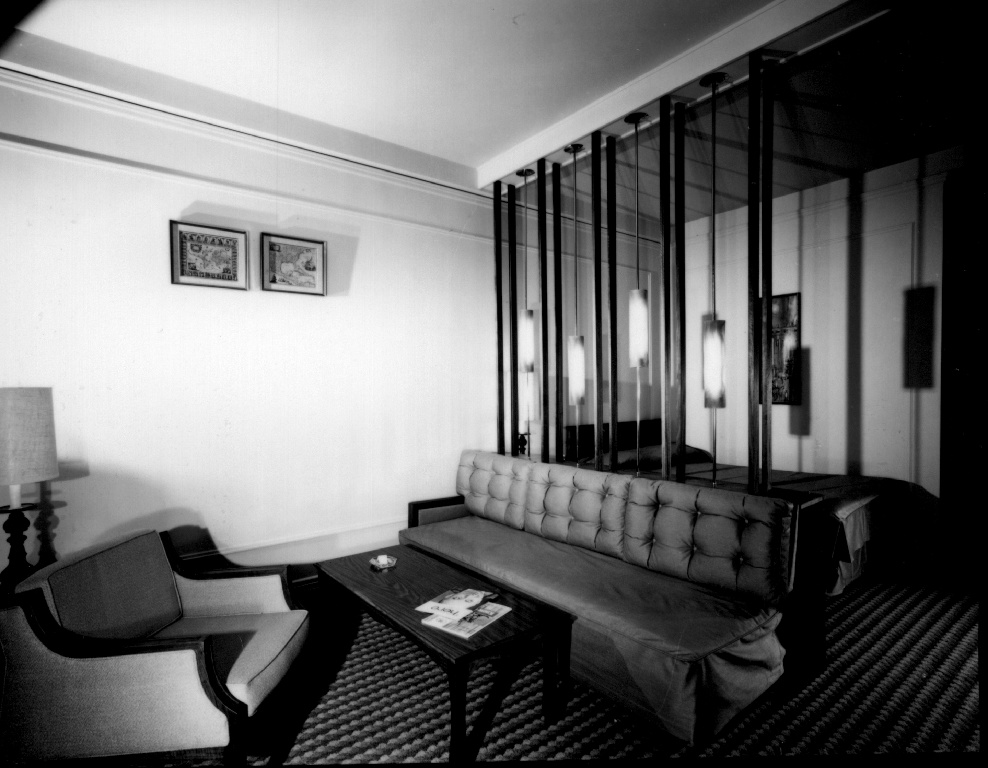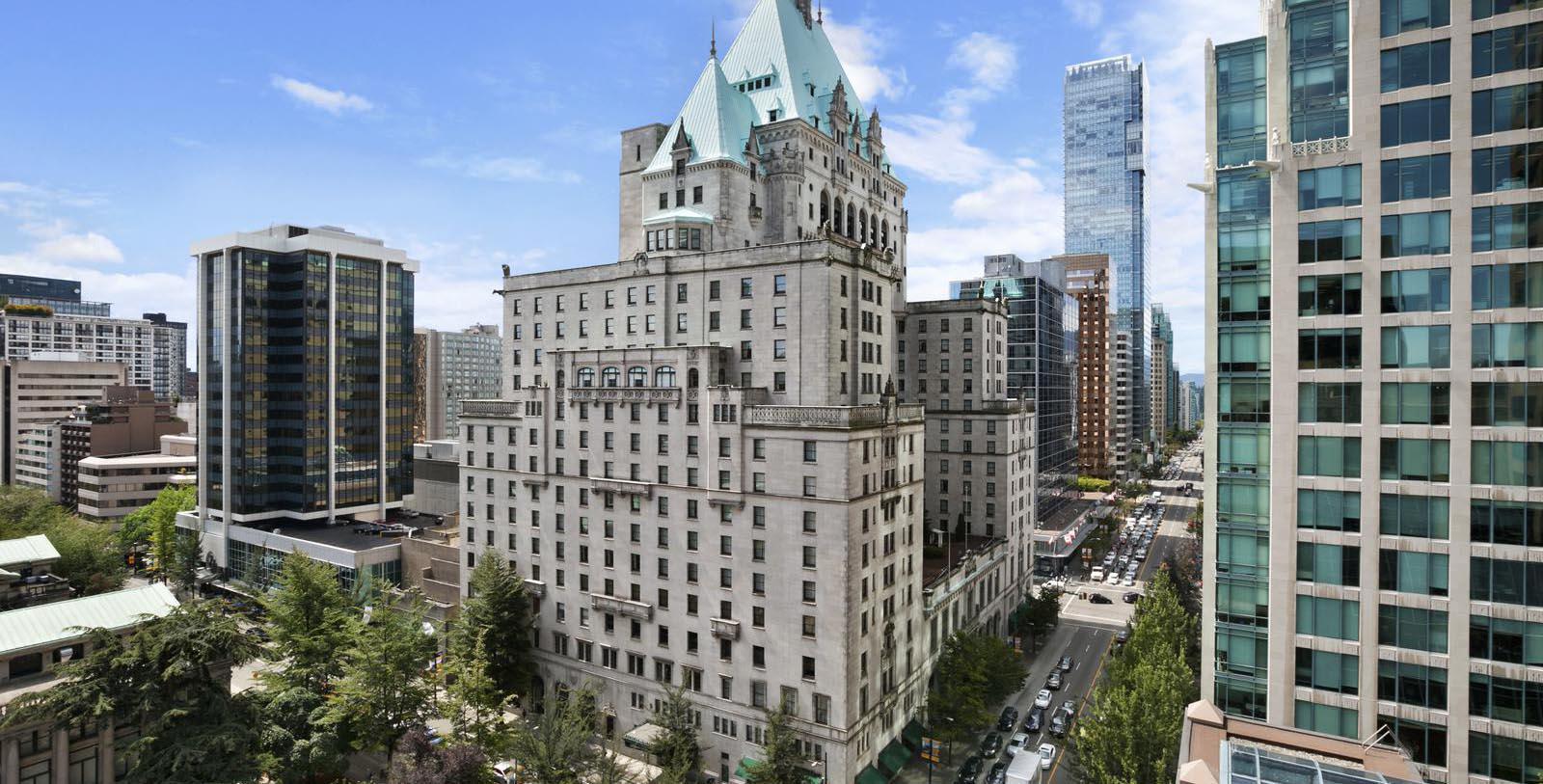Receive for Free - Discover & Explore eNewsletter monthly with advance notice of special offers, packages, and insider savings from 10% - 30% off Best Available Rates at selected hotels.
history
Discover the Fairmont Hotel Vancouver, which has been among Vancouver's most iconic landmarks since 1928.
Fairmont Hotel Vancouver, a member of Historic Hotels Worldwide since 2017, dates back to 1928.
VIEW TIMELINE
Fairmont Hotel Vancouver: Its History in 77 Seconds
Explore the history of this iconic historic destination. Opened in 1939, it is celebrated throughout Vancouver today for its timeless elegance and unrivaled luxury.
WATCH NOWA historic landmark in downtown Vancouver for nearly a century, Fairmont Hotel Vancouver is among the most exclusive places to vacation in all of Canada. Yet, the hotel is actually the third building to bear the name. The very first Hotel Vancouver debuted in 1888, shortly after the arrival of the Canadian Pacific Railway in the region. Located in the city’s Gastown neighborhood, it was a crude four-story structure that operated more like a farmhouse than a luxurious hotel. Realizing that the building was inadequately prepared to cater to contemporary travelers, the Canadian Pacific Railway decided to completely rehabilitate it. Construction on a new building commenced in 1916, with architect Francis S. Swales leading the project. What he built was an absolute engineering masterpiece. The new Hotel Vancouver stood 14 stories tall and displayed a beautiful blend of Italianate-style architecture. When it finally reopened several months later, the hotel quickly became one of the most celebrated destinations in Vancouver. Several of its facilities—including the Spanish Grill and the Red Barrel—entertained the city’s affluent night after night. The Panorama Roof in particular hosted numerous international celebrities, as well, such as Babe Ruth, Ethel Barrymore, and Sarah Bernhardt.
Toward the end of the 1920s, a competitor of Canadian Pacific Railway—Canadian National Railway—decided to open its own lavish hotel. Just two blocks away from the Hotel Vancouver, the Canadian National Railway hoped that their building would supplement travel to its marvelous Pacific Central Station. The work began in 1928, with the architectural firm Archibald and Schofield providing the design blueprints. Their vision called for the creation of a magnificent 17-story skyscraper that featured only the finest in Châteauesque-style architecture. But the economic hardships wrought from the Great Depression greatly compromised the financial security of the project. Those dire circumstances led Canadian National to strike deal with Canadian Pacific to jointly finish the construction together as co-owners. In turn, Canadian Pacific Railway agreed to shutter the Hotel Vancouver and christen the new building with the same name.
Nevertheless, numerous delays in funding caused the work to last for more than a decade. The two companies rushed to finish the project by May 1939, in order to accommodate King George VI of the United Kingdom and his wife, Queen Elizabeth The Queen Mother, during their Royal Tour of that year. The new Hotel Vancouver quickly assumed its predecessor’s role as one of the city’s premier destinations. Countless celebrities and socialites continued to grace the hotel, transforming it into a leading cultural icon. The location also emerged as a hotspot for live entertainment, as a musician named Dal Richards began leading an 11-piece band inside the hotel’s Panorama Roof Ballroom. Richards’ performances proved to be so popular that the Canadian Broadcasting Company broadcasted them live on its show, The Roof. Perhaps the most memorable of his orchestra’s performances were the lyrics of a then-unknown singer called Juliette. Born Juliette Augustina Cavazzi, she would go on to become one of Canada’s most popular entertainers throughout the mid-20th century.
The Canadian National Railway managed to acquire Canadian Pacific’s share of the hotel during the early 1960s. The company then agreed to let Hilton Hotels to operate the business on its behalf. Yet, this arrangement dissolved some 20 years later, when Canadian National decided to run the hotel itself. The decision proved to be short-lived, though, as it sold the Hotel Vancouver back to the Canadian Pacific Railway. In 2001, Canadian Pacific Railway established Fairmont Hotels and Resorts through the reorganization of its subsidiary, Canadian Pacific Hotels. Hotel Vancouver was one of several hotels that Canadian Pacific folded into the new Fairmont Hotels and Resorts, becoming the “Fairmont Hotel Vancouver” in the process. Even though Fairmont Hotels and Resorts subsequently sold the business in 2007, it still supervises the hotel’s daily operations today. Now a member of Historic Hotels Worldwide, the Fairmont Hotel Vancouver continues to be among the best holiday destinations in all of British Columbia.
-
About the Location +
One of Canada’s most preeminent cities, Vancouver’s history dates back well over a century ago. While several Native American tribes affiliated with the First Nations had inhabited the region for millennia, the first Euro-Americans did not arrive until onset of the Pacific Coast gold rush. Originating with the California Gold Rush, miners looking to strike it rich continuously traveled north along the coastline throughout the mid-19th century. By the 1860s, these aspiring entrepreneurs had reached British Columbia, establishing nascent settlements all around the Strait of Georgia. Additional settlers arrived over the next few decades, quickly replacing mining with lumber and milling as the primary industries in the region. Dozens of sawmills subsequently opened across the area, transforming the site of present-day Vancouver into one of the world’s leading producers of timber. Soon enough, railroad executives from across North America began developing railroads in the area in order to easily transport the wood to markets further south and along the East Coast. The Canadian Pacific Railway and the Canadian National Railway were the two most prominent railroad companies active in the region toward the end of the 1800s.
Eventually, the small milling villages between Burrard Inlet and Fraser River coalesced into a single community that the Canadian government formally charted as the “City of Vancouver” in 1886. While many native Canadians formed the nucleus of this nascent city, Vancouver was home to a significant population of American expats. Several of the leading sawmills in the area were operated by Americans, as was a massive sugar refinery that is still in operation today. The city’s most frequently elected mayor was a man named L.D. Taylor, who had grown up in the United States. In fact, the decision to name the city “Vancouver” had been the idea of an American known as William Van Horne. Horne was an incredibly important person in Canada at the time, as he was the President of the Canadian Pacific Railway. (The name itself was derived from an English explorer named George Vancouver, who navigated the local shoreline back in 1792.) More of the surrounding towns joined Vancouver during the early 20th century, which further enhanced its importance as a center for commerce. By the time World War II concluded, Vancouver had grown to become Canada’s third largest city, as well as its most prominent port on the Pacific Ocean—two distinctions that it still proudly bears today.
-
About the Architecture +
Historians today identify the Fairmont Hotel Vancouver as one of Canada’s grand railway hotels. These destinations appeared along Canada’s transcontinental railways throughout the late 19th and early 20th centuries, offering travelers an unprecedented way to visit nearly every province in the nation. And like most of the grand railway hotels, Fairmont Hotel Vancouver displays some of the finest Châteauesque-style design aesthetics throughout the world. Designed to resemble a historic Renaissance-era château from France’s Loire Valley, the hotel features a spectacular pitched copper roof that is outfitted with many dormers. Its steel frame has been filled with an extensive amount of carved stonework, as well. Yet, this magnificent historic hotel also incorporated several aspects of Renaissance Revival-style architecture, too, such as the use of relief sculptures and gargoyles. Several artists were even recruited to complete a variety of interior decorative work, including Olea Marion Davis, Charles Marega, and Valentine Shabief.
Construction on this Grand Dame began in 1928, although it took more than a decade to finish due to the financial hardships wrought from the Great Depression. The Grand National Railway hired the architectural firm Archibald and Schofield to oversee the creation of its design blueprints. Led by John Smith Archibald and John Schofield, the company had created a number of structures for a few of Canada’s railroad companies. The two were originally from the British Isles, with John Smith Archibald coming from Scotland and John Schofield a native of Ireland. When the Hotel Vancouver finally debuted in 1939, it stood as the tallest structure in all of Vancouver with a height of 369 feet. It maintained this status until the TD Tower opened some four decades later. Subsequent renovations to the building occurred from 2014 to 2018, when some C$12 million was invested to rehabilitate its lobby, restaurant, and guestrooms.
-
Famous Historic Events +
Royal Tour of Canada (1939): King George VI of the United Kingdom and his wife, Queen Elizabeth The Queen Mother, went on a grand journey of Canada prior to World War II. Their trip was part of a great strategy to reinforce the cultural ties that bound Canada and the United Kingdom together, as well as to emphasize the former’s increasing independence from the latter. While many other royal tours had occurred in Canada previously, this one was unprecedented in its size and scale. Thousands lined the streets of every major city that the royal entourage visited, with entire roads shutdown just to manage the crowds. King George IV and Queen Elizabeth arrived in Québec City on May 17 and started traveling west along the Canadian Pacific Railway.
The Royal Family had managed to traverse the whole country, reaching British Columbia by the end of the month. Upon their arrival on May 29, King George VI and Queen Elizabeth subsequently stayed at the Hotel Vancouver. Afterward, the King and Queen headed east to visit additional cities and towns in Atlantic Canada, as well as Newfoundland. The two also briefly traveled through the United States en route to the maritime provinces, which marked the first time a British monarch had ever stepped foot inside the country. Their journey ended on June 15, when King George VI and Queen Elizabeth The Queen Mother boarded a ship back to the United Kingdom at the port of Halifax.
-
Famous Historic Guests +
Anna Pavlova, Russian prima ballerina who performed in the Imperial Russian Ballet.
Ethel Barrymore, actress regarded by many to be “The First Lady of American Theatre.”
Sarah Bernhardt, French stage actress known for her roles in such plays like La Tosca, Ruy Blas, and La Dame Aux Cameilas.
Babe Ruth, legendary outfielder for the New York Yankees regarded today as the being best baseball player ever.
Winston Churchill, Prime Minister of the United Kingdom (1940 – 1945; 1951 – 1955)
Queen Elizabeth The Queen Mother
King George VI of the United Kingdom (1936 – 1952)
-
Film, TV and Media Connections +
Russian Roulette (1975)
Falling in Love Again (1980)
Dead Zone (1983)
The Penthouse (1989)
Bird on a Wire (1990)
The X-Files: Fire (1993)
The Santa Clause (1994)
Double Jeopardy (1999)
Get Carter (2000)
Dark Angel: Prodigy (2000)
Antitrust (2001)
Josie & the Pussycats (2001)
Life or Something Like It (2002)
Slap Shot II (2002)
La La Wood (2004)
White Chick (2004)
Are We There Yet? (2005)
The Suite Life of Zack and Cody (2005 – 2008)
She’s the Man (2006)
The Good Wife (2009)
Twilight: Eclipse (2010)
Call Me Mrs. Miracle (2010)
Fifty Shades of Grey (2015)
Age of Adeline (2015)
Fifty Shades Darker (2017)


























